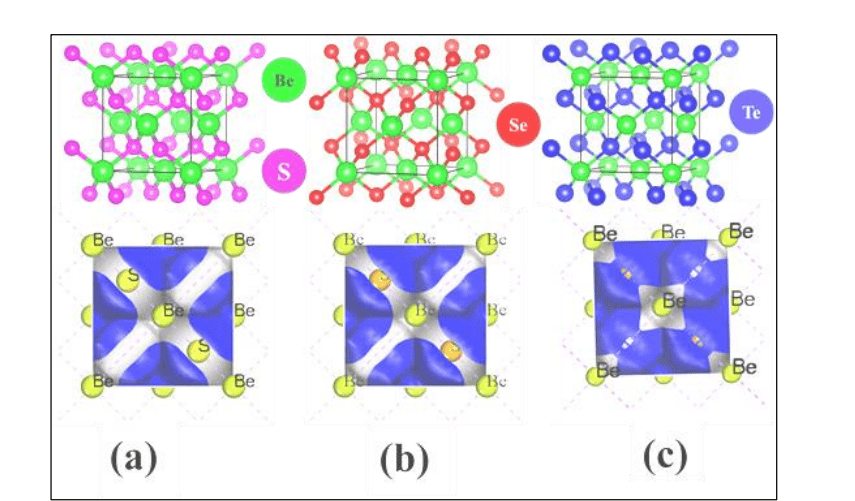Beryllium chalcogenides, compounds of beryllium and sulphur, selenium, or tellurium, present promising avenues for advanced optoelectronic technologies, and a new study investigates their behaviour under pressure. Muhammad Shahzad from the Solar Energy Research Institute Yunnan Normal University, alongside Sikander Azam from Riphah International University and Syed Awais Ahmad from Yunnan Normal University, with Ming Li, performs detailed calculations to understand how these materials respond to increasing pressure. The research reveals that these compounds remain structurally stable under significant compression, while also exhibiting strong absorption of ultraviolet light, a key property for UV-sensitive devices. By modelling the materials’ phonon spectra, optical characteristics, and thermodynamic properties, the team demonstrates the potential of beryllium chalcogenides for applications ranging from pressure sensors to thermal barriers and efficient optoelectronic components.
In this study, researchers investigate the structural, electronic, optical, and thermodynamic properties of beryllium chalcogenides, BeS, BeSe, and BeTe, under hydrostatic pressure ranging from 0 to 10 GPa. Calculations demonstrate that these compounds maintain their structural integrity across the entire applied pressure range, as confirmed by the absence of unstable vibrational modes in their analyses. This research provides fundamental insights into the behaviour of these materials under pressure, crucial for potential applications in materials science and condensed matter physics.
Beryllium Chalcogenide Heat Capacity Calculations Explained
This work details a first-principles study of the thermodynamic properties of beryllium chalcogenides under varying temperature and pressure. The research focuses on understanding how these materials store and respond to thermal energy, based on the vibrational properties of their crystal lattices. Key findings relate to heat capacity and its implications. The study investigates the temperature dependence of heat capacity for these materials. Calculations reveal that heat capacity is primarily determined by the vibrations of atoms within the crystal lattice, known as phonons.
At low temperatures, only low-frequency phonons contribute to heat capacity, while more phonons become excited as temperature increases. The Debye temperature, a crucial parameter, represents the highest frequency of these vibrational modes. Below the Debye temperature, heat capacity increases rapidly with temperature, proportional to the cube of the temperature. Above the Debye temperature, heat capacity approaches a constant value. Deviations from these ideal behaviours, caused by anharmonicity in the atomic vibrations, can influence heat capacity. The research also investigates the effect of pressure on heat capacity, finding that increasing pressure generally increases the vibrational frequencies of atoms, which can affect how the material stores thermal energy.
Beryllium Chalcogenides Remain Stable Under Pressure
This work presents a comprehensive investigation into the structural, electronic, and thermodynamic properties of beryllium chalcogenides, BeS, BeSe, and BeTe, under hydrostatic pressures ranging from 0 to 10 GPa. Calculations confirm the dynamic stability of all three compounds across the studied pressure range, demonstrated by the absence of imaginary frequencies in their analyses. The team meticulously examined the vibrational characteristics of the materials, revealing that stable vibrational modes consistently appear throughout the material, indicating robust structural integrity and resistance to variations. Structural analysis reveals that BeS, BeSe, and BeTe all crystallize in a cubic structure, with each beryllium atom surrounded by four chalcogen atoms in a tetrahedral arrangement.
Calculations of lattice parameters and bond lengths demonstrate a clear decrease with increasing pressure, indicating structural compaction. Specifically, the study quantified these changes, observing a consistent reduction in both lattice constants and bond lengths as pressure increased. Electron density distributions show high electron density around sulfur, selenium, and tellurium atoms, reflecting their higher electronegativity. Further investigations into thermodynamic properties yielded key measurements, including the Debye temperature, heat capacity, and entropy. Results demonstrate that increasing pressure leads to reduced atomic vibrations and a corresponding decrease in heat capacity. The team also observed a consistent change in the Gibbs free energy with temperature, reflecting variations in entropy. These findings highlight the potential of BeX compounds for applications in pressure-sensitive optoelectronic and thermoelectric devices, as well as thermal barrier applications, due to their tunable properties under pressure.
Beryllium Chalcogenides Stable Under High Pressure
This research presents a detailed theoretical investigation of beryllium chalcogenides, BeS, BeSe, and BeTe, comprehensively examining their structural, electronic, optical, and thermodynamic properties under pressure up to 10 GPa. Calculations demonstrate that these compounds remain dynamically stable across the studied pressure range, exhibiting pressure-induced modifications to their electronic band structures. Notably, BeS retains the widest bandgap, while all materials display strong optical absorption in the ultraviolet region, suggesting potential applications in ultraviolet optoelectronics. The team also calculated key thermodynamic parameters, revealing that increasing pressure reduces atomic vibrations and heat capacity within these materials.
These findings highlight the suitability of beryllium chalcogenides for a range of applications, including pressure-sensitive optoelectronic devices, thermal barriers, and potentially, thermoelectric materials. The authors acknowledge that systematic studies of these compounds are limited in existing literature, and this work addresses a significant gap in understanding their behaviour under varying conditions. Future research could build upon these findings through experimental validation and further exploration of their potential in specific device applications, guided by the detailed insights provided by these calculations. This work provides a valuable foundation for developing new materials with tailored properties for a variety of technological applications.
👉 More information
🗞 High-Pressure DFT Study of BeX (X = S, Se, Te): Phonon Spectra, Optical Properties, and Thermodynamic Stability for Advanced Optoelectronic Applications
🧠 ArXiv: https://arxiv.org/abs/2510.01056

